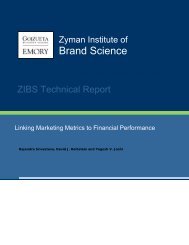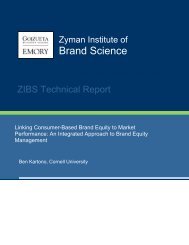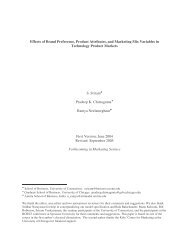The Executive's Guide to Branding - Emory Marketing Institute
The Executive's Guide to Branding - Emory Marketing Institute
The Executive's Guide to Branding - Emory Marketing Institute
You also want an ePaper? Increase the reach of your titles
YUMPU automatically turns print PDFs into web optimized ePapers that Google loves.
cash flows (as exhibited by the volatility and vulnerability of cash flows) of an<br />
investment the cost of capital is reduced. Volatility is defined as any<br />
occurrence that creates fluctuations in cash flow. Vulnerability is simply as<br />
any occurrence that negatively affects cash flow.<br />
Strong brands reduce the volatility of revenues by relevantly differentiating<br />
the offers of the firm, thereby enhancing loyalty. Enhanced loyalty lowers the<br />
long-term investments associated with maintaining a cus<strong>to</strong>mer base.<br />
Enhanced loyalty also reduces the volatility of cash-flow as the cus<strong>to</strong>mer<br />
base is less likely <strong>to</strong> switch, keeping demand more stable.<br />
While brand loyalty is expected <strong>to</strong> result in lower volatility and vulnerability<br />
of cash flows and therefore corporate risk, can this be also be expected <strong>to</strong><br />
reduce the cost of capital?<br />
<strong>The</strong> firm’s <strong>to</strong>tal cost of capital is expressed as the WACC (Weighted Average<br />
Cost of Capital). <strong>The</strong> WACC combines the cost of debt with the cost of equity.<br />
Both components can be expected <strong>to</strong> decrease with a reduction in business<br />
risk associated with the firm’s operations. Several fac<strong>to</strong>rs suggest that<br />
companies with strong brands will face lower business risk. Persistence of<br />
lower business risk should lead <strong>to</strong> lower cost of capital. Contributing fac<strong>to</strong>rs<br />
include:<br />
• Demand variability - the more stable, the lower the business risk.<br />
• Sales price variability - the less variable the lower the business risk.<br />
• Input price variability - the less variable the lower the business risk.<br />
• Market pricing power – elasticity of demand – higher brand loyalty<br />
implies lower price elasticity and therefore lower business risk<br />
Zyman <strong>Institute</strong> of Brand Science – Perspectives 11





